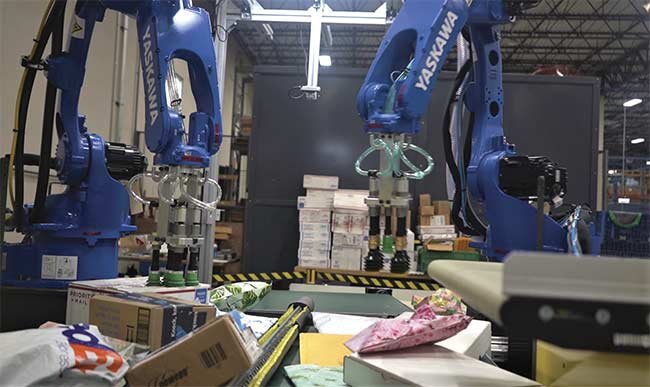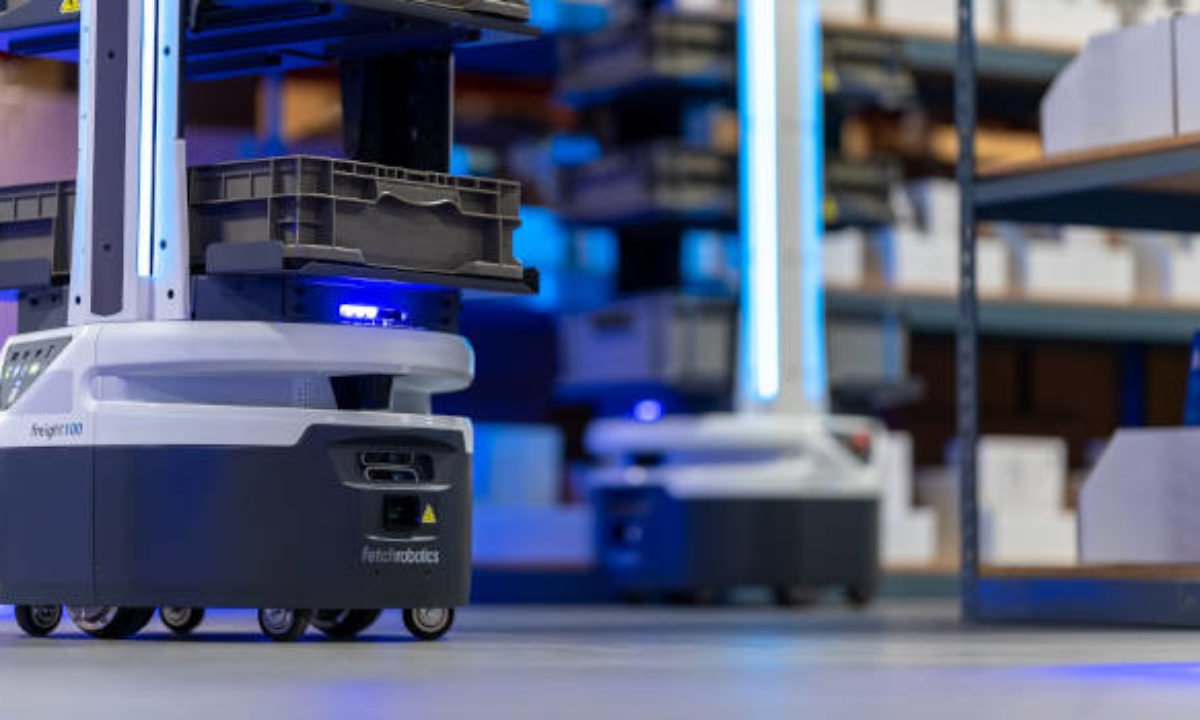key takeaways
- Enhanced Productivity: Robots led by vision can provide increased productivity in warehouse operations. They can swiftly and precisely complete activities, navigate challenging settings, and precisely identify and find objects. As a result, operations become more efficient and quick, using less time and effort to complete different logistical tasks.
- Improved Accuracy: Vision guided robots identify and manipulate items with greater accuracy by making use of sophisticated image systems and algorithms. Errors like misplacing or damage during transit or sorting are less likely as a result. The robots’ constant high accuracy task performance enhances overall operational reliability and aids in quality control.
- Flexibility and Adaptability: Robots driven by vision are made to be flexible enough to adjust to changing conditions. They can manage a variety of items and package variants because they have the ability to detect and adjust to changes in object shape, size, or location. This adaptability makes it possible to handle a variety of things in logistics effectively, meeting shifting needs and minimizing the need for manual intervention.
- Safety and Ergonomics: Vision guided robots help to improve worker safety and ergonomics by automating repetitive or physically taxing tasks. They may carry out jobs in dangerous settings or manage big weights, which lowers the chance of accidents or exposure to potentially dangerous situations. As a result, human workers can concentrate on more difficult or valuable jobs in a safer work environment.
- Data and analytics: During operations, vision guided robots produce useful data that may be used to monitor performance and optimize processes. Logistics managers can find opportunities for improvement and make data-driven decisions by using the robots’ ability to gather information about inventory, cycle times, and other pertinent metrics. This data-driven strategy aids in resource allocation optimization and improves operational efficiency.
- Scalability and Cost-Effectiveness: Vision guided robots provide scalability benefits as the need for logistical operations increases. Logistics facilities are able to expand their operations without having to make major infrastructure improvements because they are simple to incorporate into current systems and processes. Furthermore, by decreasing human requirements and avoiding errors that may result in expensive rework or returns, the automation these robots enable can result in long-term cost benefits.
- Enhanced Customer Experience: The advantages of vision-guided robots in logistics also apply to the clientele. These robots help to increase customer satisfaction by facilitating quicker order fulfillment, precise tracking, and on-time deliveries. These systems’ dependability and efficiency contribute to meeting client expectations for quicker, error-free service, which boosts customer loyalty and improves brand perception.

Enhanced Efficiency
Implementing vision guided robots in logistics can greatly enhance efficiency. These robots are equipped with advanced vision systems that allow them to quickly and accurately locate and retrieve items. They can efficiently navigate through warehouses, picking and packing items at a much faster rate than human workers. This increased efficiency leads to faster order fulfillment and improved productivity.
Additionally, vision guided robots can optimize warehouse layouts and improve inventory management. By analyzing the layout of the warehouse and the location of items, these robots can suggest more efficient storage configurations, reducing the time and effort required to locate and retrieve items. This automation of warehouse operations can lead to significant time and cost savings.
Improved Accuracy
One of the key benefits of using vision guided robots in logistics is improved accuracy. These robots are equipped with advanced vision systems that allow them to precisely identify and handle items. They can scan barcodes, read labels, and capture images to ensure accurate item identification and tracking.
In addition, vision guided robots can perform precise measurements and weight checks, ensuring that items are correctly packaged and labeled. This reduces the risk of errors and minimizes the chances of incorrect shipments, leading to improved customer satisfaction and reduced returns or exchanges.
Increased Safety
Implementing vision guided robots in logistics can significantly increase safety in the workplace. These robots are designed to operate in a safe and controlled manner, reducing the risk of accidents and injuries.
By automating repetitive and physically demanding tasks, vision guided robots can help reduce the strain on human workers, minimizing the risk of musculoskeletal injuries. They can also navigate through the warehouse environment without colliding with obstacles or other workers, further improving safety.
Furthermore, vision guided robots can be equipped with sensors and cameras that provide real-time monitoring of the workspace. This allows them to detect and react to potential hazards, such as spills or obstructions, ensuring a safe working environment for both robots and human employees.
Cost Savings
Implementing vision guided robots in logistics can lead to significant cost savings. These robots can perform tasks with high levels of efficiency and accuracy, reducing the need for manual labor and minimizing human errors.
By automating repetitive tasks, vision guided robots can free up human workers to focus on more complex and value-added activities. This not only improves overall productivity but also allows companies to optimize their workforce and allocate resources more effectively.
Additionally, vision guided robots can help reduce the risk of inventory shrinkage and loss. With their precise tracking and identification capabilities, these robots can minimize errors in inventory management, ensuring that items are properly accounted for and reducing the need for costly audits or inventory reconciliations.
Overall, the cost savings achieved through the implementation of vision guided robots in logistics can contribute to improved profitability and competitiveness in the industry.
Enhanced Customer Satisfaction
Using vision guided robots in logistics can greatly enhance customer satisfaction. These robots can ensure accurate and timely order fulfillment, reducing the likelihood of delayed shipments or incorrect deliveries.
With their advanced vision systems, vision guided robots can accurately identify and handle items, ensuring that customers receive the correct products in the right condition. This can help improve the overall customer experience and build trust and loyalty.
Furthermore, the increased efficiency and accuracy provided by vision guided robots can result in faster order processing and shorter delivery times. Customers can receive their orders more quickly, leading to higher satisfaction and a positive brand image.
In summary, the implementation of vision guided robots in logistics can have a significant positive impact on customer satisfaction, ultimately contributing to the success and growth of the business.
conclusion
In conclusion, the advantages of implementing vision guided robots in the logistics industry are clear and impactful. From enhanced efficiency and improved accuracy to increased safety, cost savings, and enhanced customer satisfaction, these robots offer a myriad of benefits that can revolutionize warehouse operations. By leveraging advanced vision systems and automation technology, companies can streamline their processes, reduce errors, and optimize their resources to stay competitive in today’s fast-paced market. Ultimately, the integration of vision guided robots in logistics not only improves operational efficiency but also enhances overall customer experience, driving success and growth for businesses in the industry.

FAQ
How can AI help the logistics industry?
AI can help the logistics industry in a multitude of ways. By utilizing AI-powered algorithms and machine learning systems, companies can optimize route planning and scheduling, leading to more efficient and cost-effective transportation of goods. AI can also analyze large amounts of data to identify trends and patterns, enabling companies to make data-driven decisions and improve overall operational performance. Additionally, AI can be used for predictive maintenance of vehicles and equipment, reducing downtime and minimizing disruptions in the supply chain. Overall, AI has the potential to revolutionize the logistics industry by enhancing decision-making, streamlining processes, and improving overall efficiency.
How can robots help with logistics?
Robots can help with logistics in a multitude of ways. By implementing vision guided robots in warehouse operations, companies can greatly enhance efficiency and accuracy in picking, packing, and handling items. These robots are equipped with advanced vision systems that enable them to quickly locate and retrieve items, optimize warehouse layouts, and improve inventory management. Additionally, robots can perform precise measurements and weight checks, ensuring that items are correctly packaged and labeled, leading to reduced errors and improved customer satisfaction.
Furthermore, robots can increase safety in the workplace by automating repetitive tasks and reducing the strain on human workers. Equipped with sensors and cameras for real-time monitoring, robots can detect and react to potential hazards, creating a safer environment for both robots and human employees. This increased safety can help minimize accidents and injuries, ultimately contributing to a more secure and productive working environment.
Overall, the integration of robots in logistics not only streamlines processes and reduces costs but also enhances operational efficiency and customer satisfaction. By leveraging robotics technology, companies can stay competitive in the industry and drive success and growth in their business.
Will logistics be replaced by AI?
While there is no denying that AI is transforming the logistics industry, it is unlikely that logistics will be entirely replaced by AI. Instead, AI will continue to complement and enhance existing logistics operations. By leveraging AI-powered algorithms and machine learning systems, companies can streamline processes, optimize route planning, and make data-driven decisions. This will ultimately lead to more efficient and cost-effective transportation of goods.
AI can also help improve inventory management, warehouse operations, and overall supply chain efficiency. By analyzing data and identifying trends, AI can help companies identify areas for improvement and make strategic decisions to optimize their logistics operations. Additionally, AI can be used for predictive maintenance to reduce downtime and minimize disruptions in the supply chain.
Ultimately, while AI will play a significant role in shaping the future of logistics, human expertise and intervention will still be essential. The human touch will be necessary for decision-making, problem-solving, and ensuring that AI systems are operating effectively. By embracing AI as a tool to enhance logistical operations, companies can stay competitive in the industry and drive success and growth in their business.
Will logistics be replaced by AI?
The purpose of robotics in the logistics industry is to revolutionize warehouse operations and enhance efficiency, accuracy, and safety. By leveraging advanced vision systems and automation technology, robots can optimize storage configurations, improve inventory management, and streamline picking, packing, and handling processes. These robots are equipped with sensors and cameras for real-time monitoring, enabling them to detect and react to potential hazards, ultimately creating a safer working environment for both robots and human employees. Overall, the purpose of robotics in logistics is to drive success and growth in businesses by improving operational efficiency, reducing costs, and enhancing customer satisfaction.
I hope this article was helpful for more check out our previous blogpost by clinking here

